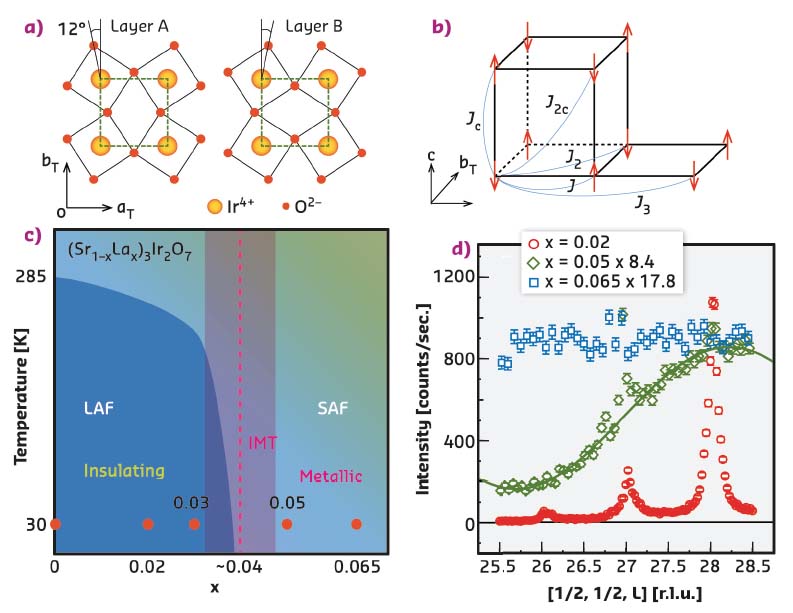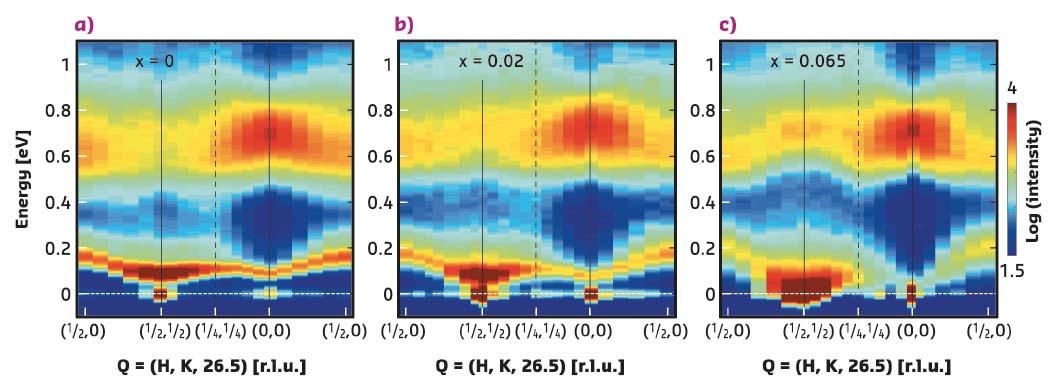- Home
- Users & Science
- Scientific Documentation
- ESRF Highlights
- ESRF Highlights 2017
- Electronic structure, magnetism and dynamics
- Two-dimensional short range antiferromagnetic state in highly doped metallic (Sr1-xLax)3Ir2O7
Two-dimensional short range antiferromagnetic state in highly doped metallic (Sr1-xLax)3Ir2O7
Doping Mott insulators with charge carriers usually generates various new phases. A RIXS study of the evolution of the magnetic order and magnetic excitations reveals that electron doping drives (Sr1-xLax)3Ir2O7 into a correlated metallic state with two-dimensional short range antiferromagnetic order and a vanishing spin gap.
High temperature superconductivity in copper oxides arises from doping charge carriers into their Mott insulating antiferromagnetic parent compounds [1]. In addition to superconductivity, various exotic quantum states emerge in close proximity to the metal-insulator transition. Many of the characteristic signatures of superconducting copper oxides are also realized in 5d iridium oxide-based Mott insulators. For example, Sr2IrO4 [2] is a layered perovskite iridate hosting a novel spin-orbit coupling-induced Mott insulating state [2]. The magnetic order, spin dynamics, and electronic structure of Sr2IrO4 are similar to the prototypical copper oxide La2CuO4 [3].
In Sr2IrO4 collective quantum states emerge by charge-carrier doping in the strong spin-orbit coupling (SOC) limit, which suggests that electron-doped Sr2IrO4 is an analogous material to hole-doped La2CuO4 [4]. Compared with Sr2IrO4, the bilayer Sr3Ir2O4 is similar to bilayer cuprates, which exhibit higher Tc than monolayer copper oxides [1]. It is a promising candidate for exploring novel phases via electron doping since it retains the Jeff = 1/2 Mott state while lying close to an insulator-to-metal transition (IMT) with a small gap of ΔE ≈ 130 meV. Strong interlayer coupling and magnetic anisotropy induce a c-axis G-type antiferromagnetic order (AFM) below TN ≈ 285 K and distinct magnons bearing a large magnon gap ≈ 90 meV [5] (Figures 105a and b). Because of the small charge gap of Sr3Ir2O7, an IMT and a robust metallic state have been realised in (Sr1-xLax)3Ir2O7 for x > 0.05 (Figure 105c).
 |
|
Fig. 105: a) In-plane crystal structure of Sr3Ir2O7. b) G-type collinear antiferromagnetic order with moment along the c axis. c) Schematic phase diagram of (Sr1-xLax)3Ir2O7. LAF and SAF are long range and short range antiferromagnetic order, respectively. d) Doping dependent L scans across the magnetic Bragg peak (1/2, 1/2, 28). The green solid curve in (d) is a fit of the L scan for x = 0.05. |
Since small amounts of La dopants have little structural effect on IrO2 layers while driving the system across the IMT, (Sr1-xLax)3Ir2O7 provides an ideal platform for exploring novel phenomena arising from charge carrier doped novel Mott states. However, the doping evolution of (Sr1-xLax)3Ir2O7 and the nature of the metallic state, being debated to be a Fermi liquid or a correlated metal, is still unclear. In order to address this, detailed studies of the doping-dependent magnetic order and elementary excitations are required.
In this work, the doping dependence of the magnetic order and the elementary excitations across the IMT in (Sr1-xLax)3Ir2O7 were studied using Ir L3 edge resonant inelastic X-ray scattering (RIXS). The experiments were carried out at ID20 and at 27-ID-B of APS, Argonne National Laboratory. The use of the state-of-the-art hard X-ray RIXS spectrometers with very high resolution (~ 25 meV) was essential for the measurements, which enabled the tracking of the doping evolution of the magnetic order and magnetic excitations [6].
 |
|
Fig. 106: a) - c) In-plane momentum dependence of RIXS spectra of (Sr1-xLax)3Ir2O7 for x = 0, 0.02, and 0.065. |
The results reveal an evolution of the AFM from three-dimensional (3D) long range AFM (LAF) ( x ≤ 0.03) to 3D short range AFM (SAF) (x ~ 0.05) across the IMT and subsequent 2D SAF deep in the metallic state (x = 0.065) (Figures 105c and d). Following the evolution of the magnetic order, Figure 106 shows that magnetic excitations undergo damping, anisotropic softening, and gap collapse, accompanied by weakly doping-dependent spin-orbit excitons. This indicates that the emergent itinerant electrons suppress the AFM by weakening the magnetic couplings and drive the system into a 2D SAF correlated metallic state hosting strong antiferromagnetic fluctuations of the Jeff = 1/2 moments. The correlated metallic state hosting strong AFM spin fluctuations of Jeff = 1/2 in (Sr1-xLax)3Ir2O7 provides a new platform for realising novel quantum phases by applying internal or external perturbations.
Principal publication and authors
Doping Evolution of Magnetic Order and Magnetic Excitations in (Sr1-xLax)3Ir2O7 , X. Lu (a), D. E. McNally (a), M. Moretti Sala (b), J. Terzic (c,d), M. H. Upton (e), D. Casa (e), G. Ingold (f), G. Cao (c,d) and T. Schmitt (a), Phys. Rev. Lett. 118, 027202 (2017), doi: 10.1103/PhysRevLett.118.027202.
(a) Synchrotron Radiation and Nanotechnology Division, Paul Scherrer Institut, Villigen PSI (Switzerland)
(b) ESRF
(c) Department of Physics and Astronomy, University of Kentucky, Kentucky (USA)
(d) Department of Physics, University of Colorado at Boulder, Colorado (USA)
(e) Advanced Photon Source, Argonne National Laboratory, Argonne, Illinois (USA)
(f) SwissFEL, Paul Scherrer Institut, Villigen PSI (Switzerland)
References
[1] P. A. Lee et al., Rev. Mod. Phys. 78, 17 (2006).
[2] J.G. Rau et al., Annu. Rev. Condens. Matter Phys. 7, 195 (2015).
[3] H. Gretarsson et al., Phys. Rev. Lett. 117, 107001 (2016).
[4] F. Wang and T. Senthil, Phys. Rev. Lett. 106, 136402 (2011).
[5] M. Moretti Sala et al., Phys. Rev. B 92, 024405 (2015).
[6] C. Donnerer et al., ESRF Highlights 2016 14 (2016).



